APPLE PIE FILLING IN A JAR
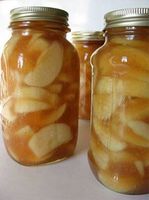
6 quarts sliced fresh apples (firm crisp apples are best)(about 30 apples)
5 cups sugar
1 1/2 cups Clear Jel
1 Tablespoon cinnamon
2 1/2 cups water
5 cups apple juice
3/4 cup bottled lemon juice
Combine sugar, Clear Jel, cinnamon, water and apple juice in a large pot. Stir and cook on medium high heat until the mixture thickens and begins to bubble. Add lemon juice and boil for 1 minute, stirring constantly. Add drained apple slices to sauce.
Fill jars with mixture, leaving 1 -inch head space. I packed the jars with the apples and then divided sauce among the jars.
Wipe jar rims clean, tighten lids and process immediately. Place jars in pot of water with water 1 inch above top of jar lids and boil for 25 minutes. Remove from water and let jars cool 12 to 24 hours. Lids should be indented if properly sealed. Now they are ready to be saved for later or wrapped for gifts.
5 cups sugar
1 1/2 cups Clear Jel
1 Tablespoon cinnamon
2 1/2 cups water
5 cups apple juice
3/4 cup bottled lemon juice
Combine sugar, Clear Jel, cinnamon, water and apple juice in a large pot. Stir and cook on medium high heat until the mixture thickens and begins to bubble. Add lemon juice and boil for 1 minute, stirring constantly. Add drained apple slices to sauce.
Fill jars with mixture, leaving 1 -inch head space. I packed the jars with the apples and then divided sauce among the jars.
Wipe jar rims clean, tighten lids and process immediately. Place jars in pot of water with water 1 inch above top of jar lids and boil for 25 minutes. Remove from water and let jars cool 12 to 24 hours. Lids should be indented if properly sealed. Now they are ready to be saved for later or wrapped for gifts.
APRICOT IN BRANDY
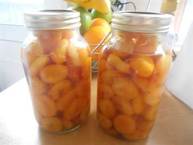
500 grams fresh or dried apricots
140 grams white sugarbrandy to cover
Mix the apricots and sugar together and add sufficient brandy to cover. Pack into hot, dry, sterilized jars and leave to mature for at least 14 days before use.
Asafoetida Powder Substitutes
For ½ teaspoon asafoetida, one can use 2 peeled and minced garlic cloves. Then sauté in some ghee or vegetable oil and you'll never really know the difference!
Those who want a dominant onion flavor, ca...n opt for ⅓ cup of minced leeks or onions along with a single clove of garlic, also minced, for to substitute for ½ teaspoon of asafoetida.
Also, you can substitute ¼ teaspoon of asafoetida with a blend of ¼ teaspoon of garlic powder and an equal portion of onion powder
140 grams white sugarbrandy to cover
Mix the apricots and sugar together and add sufficient brandy to cover. Pack into hot, dry, sterilized jars and leave to mature for at least 14 days before use.
Asafoetida Powder Substitutes
For ½ teaspoon asafoetida, one can use 2 peeled and minced garlic cloves. Then sauté in some ghee or vegetable oil and you'll never really know the difference!
Those who want a dominant onion flavor, ca...n opt for ⅓ cup of minced leeks or onions along with a single clove of garlic, also minced, for to substitute for ½ teaspoon of asafoetida.
Also, you can substitute ¼ teaspoon of asafoetida with a blend of ¼ teaspoon of garlic powder and an equal portion of onion powder
APPLE & GINGER CHUTNEY
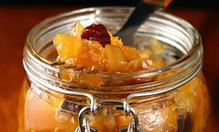
Ingredients
30 ml sunflower or canola oil
1 large onion, finely chopped
1 large cooking apple, peeled and cut into 1/2-cm dice
125 ml Safari Pitted Dates, chopped coarsely
125 ml Safari Seedless Raisins
45 ml finely diced ginger root (1/2 cm)
10 - 15 ml dried red chili flakes (or to taste)
125 ml sugar
65 ml white vinegar
125 ml clear apple juice
salt and freshly-milled black pepper
Method
Heat the oil and add the onion and apple. Sauté until translucent then add the rest of the ingredients except the seasoning.
Bring to the boil, reduce heat and simmer for about 15 - 20 minutes or until the apples are tender (but not mushy) and the liquids have reduced and thickened to your liking - you either like your chutneys dry-ish or syrupy.
A great way to reduce liquids is to remove the lid from a saucepan, increasing the heat and cooking the food rapidly until the liquids have reduced and naturally thickened. You will need to watch it though, this could be a recipe for a burnt disaster ..!
When the chutney is cooked to your liking, season to taste and serve with cheese and biscuits, pork, lamb or smoked fish or chicken.
Yields about 325 ml chutney (do store in the fridge)
30 ml sunflower or canola oil
1 large onion, finely chopped
1 large cooking apple, peeled and cut into 1/2-cm dice
125 ml Safari Pitted Dates, chopped coarsely
125 ml Safari Seedless Raisins
45 ml finely diced ginger root (1/2 cm)
10 - 15 ml dried red chili flakes (or to taste)
125 ml sugar
65 ml white vinegar
125 ml clear apple juice
salt and freshly-milled black pepper
Method
Heat the oil and add the onion and apple. Sauté until translucent then add the rest of the ingredients except the seasoning.
Bring to the boil, reduce heat and simmer for about 15 - 20 minutes or until the apples are tender (but not mushy) and the liquids have reduced and thickened to your liking - you either like your chutneys dry-ish or syrupy.
A great way to reduce liquids is to remove the lid from a saucepan, increasing the heat and cooking the food rapidly until the liquids have reduced and naturally thickened. You will need to watch it though, this could be a recipe for a burnt disaster ..!
When the chutney is cooked to your liking, season to taste and serve with cheese and biscuits, pork, lamb or smoked fish or chicken.
Yields about 325 ml chutney (do store in the fridge)
HEINER'S APPLE CHUTNEY
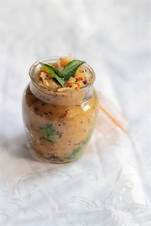
1 kg apples
250 g onions
150 g raisins or sultanas
350 g sugar
heaped desert spoon of paprika
heaped desert spoon of mixed spice
quarter teaspoon of cayenne pepper
teaspoon of salt
750 ml malt vinegar
Core your apples and slice them into small pieces, each one no larger than a sugar cube.
Don’t peel them, as the skin will add texture to the finished chutney.
Dice the onions, and put these, the apples and other ingredients into a heavy-bottomed pan.
A jam making pan is ideal here.
Ensure that all of the ingredients are well mixed and that the vinegar covers the apples and onions.
Gently bring to the boil, stirring frequently to ensure that the sugar doesn’t sink to the bottom and caramelise on the base of the pan, or it will be difficult to remove once you have finished cooking.
When it has reached boiling point, reduce the temperature to a simmer and allow to cook for around an hour and a half, again stirring frequently.
You should notice that the chutney mixture starts to thicken, and many recipes state that you should be able to draw your spoon across the bottom of the pan, with the mixture separating around it and then only slowly sliding back into place.
However, even with four hours of cooking we have not had this happen with any chutney.
Instead, then, ensure that all of the mixture is starting to get sticky and bind together and then remove from the heat.
Your total cooking time for this quantity of mixture will likely be close to two hours.
It will be more if you have increased the quantities.
Carefully spoon the chutney into sterilised jars, seal them and then leave them in a dark cupboard to mature for 2 to 3 months before opening the first one.
250 g onions
150 g raisins or sultanas
350 g sugar
heaped desert spoon of paprika
heaped desert spoon of mixed spice
quarter teaspoon of cayenne pepper
teaspoon of salt
750 ml malt vinegar
Core your apples and slice them into small pieces, each one no larger than a sugar cube.
Don’t peel them, as the skin will add texture to the finished chutney.
Dice the onions, and put these, the apples and other ingredients into a heavy-bottomed pan.
A jam making pan is ideal here.
Ensure that all of the ingredients are well mixed and that the vinegar covers the apples and onions.
Gently bring to the boil, stirring frequently to ensure that the sugar doesn’t sink to the bottom and caramelise on the base of the pan, or it will be difficult to remove once you have finished cooking.
When it has reached boiling point, reduce the temperature to a simmer and allow to cook for around an hour and a half, again stirring frequently.
You should notice that the chutney mixture starts to thicken, and many recipes state that you should be able to draw your spoon across the bottom of the pan, with the mixture separating around it and then only slowly sliding back into place.
However, even with four hours of cooking we have not had this happen with any chutney.
Instead, then, ensure that all of the mixture is starting to get sticky and bind together and then remove from the heat.
Your total cooking time for this quantity of mixture will likely be close to two hours.
It will be more if you have increased the quantities.
Carefully spoon the chutney into sterilised jars, seal them and then leave them in a dark cupboard to mature for 2 to 3 months before opening the first one.
ORCHARD APPLE CHUTNEY
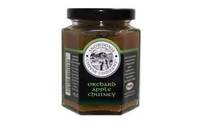
2 cups rice vinegar
¾ cup packed brown sugar
½ large red bell pepper - diced
2 large jalapeno peppers - seeded and diced
2 tablespoons diced yellow onion
3 tart - firm apples - peeled - cored and diced
juice of 1 lemon
Sterilize 2 x 300 ml canning jars and keep them hot.
Bring the vinegar and sugar to a boil in a large saucepan.
Stir to dissolve the sugar completely.
Add the bell pepper, jalapenos, and onion and continue to boil for 8 minutes.
Add the apples, reduce the heat and simmer until the apples are tender, about 10 minutes more.
Remove from the heat and stir in the lemon juice.
Spoon or ladle the chutney into the jars.
Cap the jars according to the manufacturer's directions.
Process for 10 minutes in a boiling water bath.
Let cool and test for a seal.
Stored in a cool, dry, dark place, the chutney will last indefinitely.
Good with smoked turkey, pheasant, sausage patties and biscuits.
VARIATION
If you do not want to process and can the chutney, spoon or ladle it into sterilized lidded jars.
Let cool slightly and refrigerate.
This version will keep for 2 weeks in the refrigerator.
¾ cup packed brown sugar
½ large red bell pepper - diced
2 large jalapeno peppers - seeded and diced
2 tablespoons diced yellow onion
3 tart - firm apples - peeled - cored and diced
juice of 1 lemon
Sterilize 2 x 300 ml canning jars and keep them hot.
Bring the vinegar and sugar to a boil in a large saucepan.
Stir to dissolve the sugar completely.
Add the bell pepper, jalapenos, and onion and continue to boil for 8 minutes.
Add the apples, reduce the heat and simmer until the apples are tender, about 10 minutes more.
Remove from the heat and stir in the lemon juice.
Spoon or ladle the chutney into the jars.
Cap the jars according to the manufacturer's directions.
Process for 10 minutes in a boiling water bath.
Let cool and test for a seal.
Stored in a cool, dry, dark place, the chutney will last indefinitely.
Good with smoked turkey, pheasant, sausage patties and biscuits.
VARIATION
If you do not want to process and can the chutney, spoon or ladle it into sterilized lidded jars.
Let cool slightly and refrigerate.
This version will keep for 2 weeks in the refrigerator.
AAM KI LAUNJI
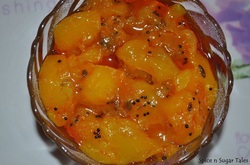
Raw mangoes are supposed to be "cooling" for our body system. To beat the intense desert heat, a drink called "kairi ka pani" is made using raw mango pulp, flavoured with jeera powder, sugar and black salt. This recipe is another way to combat the heat. Raw mangoes are tempered with fennel and nigella seeds and simmered with spices and sugar to make an instant pickle that can be served with afternoon meals.
Ingredients
1 cup raw mango , peeled and cubed
1/2 tsp fennel seeds (saunf)
1/4 tsp nigella seeds (kalonji)
3 tsp coriander (dhania) powder
1 tsp chilli powder
1/4 tsp turmeric powder (haldi)
1/3 cup sugar
2 tbsp oil
salt to taste
Method
Heat the oil in a pan, add the fennel seeds, nigella seeds and mango pieces and sauté for 2 minutes.
Add the coriander powder, chilli powder, turmeric powder, sugar and salt with 4 tablespoons of water. Stir and simmer till the sugar has dissolved.
Allow to cool completely.
Store refrigerated for up to 4 days.
Ingredients
1 cup raw mango , peeled and cubed
1/2 tsp fennel seeds (saunf)
1/4 tsp nigella seeds (kalonji)
3 tsp coriander (dhania) powder
1 tsp chilli powder
1/4 tsp turmeric powder (haldi)
1/3 cup sugar
2 tbsp oil
salt to taste
Method
Heat the oil in a pan, add the fennel seeds, nigella seeds and mango pieces and sauté for 2 minutes.
Add the coriander powder, chilli powder, turmeric powder, sugar and salt with 4 tablespoons of water. Stir and simmer till the sugar has dissolved.
Allow to cool completely.
Store refrigerated for up to 4 days.
BANANA CHUTNEY
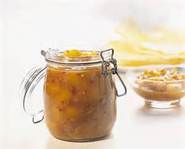
30 bananas
1 ½ bot. vinegar
½ pound seeded raisins (1 kop)
1 small onion, chopped
1 pound brown sugar ( 2 kop)
2 tablespoons ground ginger
2 chopped chillies
1 tablespoon salt
METHOD:
1. Peel and slice the bananas.
2. Combine all the ingredients and cook in the vinegar for 1 ½ to 2 hours.
3. Bottle and seal while still hot.
1 ½ bot. vinegar
½ pound seeded raisins (1 kop)
1 small onion, chopped
1 pound brown sugar ( 2 kop)
2 tablespoons ground ginger
2 chopped chillies
1 tablespoon salt
METHOD:
1. Peel and slice the bananas.
2. Combine all the ingredients and cook in the vinegar for 1 ½ to 2 hours.
3. Bottle and seal while still hot.
MRS JENNEY B'S CHUTNEY
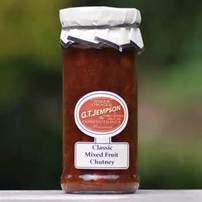
Makes 7 x 450 g jam jars.
Cooking time 1¼ - 1½ hours
"It is actually a rather hit and miss recipe, not to be taken too seriously.
You can change the taste as you prefer."
1 kg apples (after peeling and coring) – I use sour apples
500 g onions
1 kg plums or prunes
750 g tomatoes (green or red – peel red)
100 g preserved *ginger
12 dried *chillies
1 clove of garlic
500 g seedless raisins or sultanas
750 g Demerara sugar
50 g salt
½ tsp ground black pepper
1 ½ tbsp ground mixed spice
½ pkt dried apricots (soaked in water the night before) #
¾ pint malt vinegar (British pint = 20 oz)
Put the apples, apricots and onions through a coarse mincer.
Wash and stone the plums/prunes and cut into small pieces, with the tomatoes (skinned if ripe).
Chop the ginger and the chillies and garlic finely.
Turn everything into a large heavy bottomed saucepan, preferably deep.
Bring everything to the boil gently, until the sugar is dissolved.
Boil, stirring occasionally (careful it spits and can cause severe burns!) at first and continuously towards the end, for 1¼ - 1½ hours.
I use my stab mixer to make it more liquid.
Pour into warm bottles and seal immediately.
*Here is where you can change the taste of the chutney.
NOTE
If a less hot chutney is preferred, omit the ginger and a few of the chillies.
Cooking time 1¼ - 1½ hours
"It is actually a rather hit and miss recipe, not to be taken too seriously.
You can change the taste as you prefer."
1 kg apples (after peeling and coring) – I use sour apples
500 g onions
1 kg plums or prunes
750 g tomatoes (green or red – peel red)
100 g preserved *ginger
12 dried *chillies
1 clove of garlic
500 g seedless raisins or sultanas
750 g Demerara sugar
50 g salt
½ tsp ground black pepper
1 ½ tbsp ground mixed spice
½ pkt dried apricots (soaked in water the night before) #
¾ pint malt vinegar (British pint = 20 oz)
Put the apples, apricots and onions through a coarse mincer.
Wash and stone the plums/prunes and cut into small pieces, with the tomatoes (skinned if ripe).
Chop the ginger and the chillies and garlic finely.
Turn everything into a large heavy bottomed saucepan, preferably deep.
Bring everything to the boil gently, until the sugar is dissolved.
Boil, stirring occasionally (careful it spits and can cause severe burns!) at first and continuously towards the end, for 1¼ - 1½ hours.
I use my stab mixer to make it more liquid.
Pour into warm bottles and seal immediately.
*Here is where you can change the taste of the chutney.
NOTE
If a less hot chutney is preferred, omit the ginger and a few of the chillies.
CHERRIES IN ROSE- VANILLA SYRUP
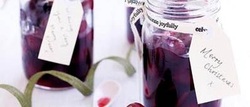
1 kg cherries
strips of orange rind
½ cup demerara or white sugar
750 ml rosé
1 vanilla bean
Split vanilla bean lengthways and with the tip of the knife, scrape out seeds.
Add scraped bean and seeds to pan with rosé, sugar and orange rind.
Stir over medium heat until sugar has dissolved and mixture comes to the boil.
Reduce heat and simmer for 5 minutes.
Add cherries and simmer gently for a further 5 minutes.
Transfer cherries to a sterlised clean jar using a slotted spoon.
Boil liquid for a further 8 minutes.
Pour liquid over cherries.
Seal.
strips of orange rind
½ cup demerara or white sugar
750 ml rosé
1 vanilla bean
Split vanilla bean lengthways and with the tip of the knife, scrape out seeds.
Add scraped bean and seeds to pan with rosé, sugar and orange rind.
Stir over medium heat until sugar has dissolved and mixture comes to the boil.
Reduce heat and simmer for 5 minutes.
Add cherries and simmer gently for a further 5 minutes.
Transfer cherries to a sterlised clean jar using a slotted spoon.
Boil liquid for a further 8 minutes.
Pour liquid over cherries.
Seal.
DATE CHUTNEY
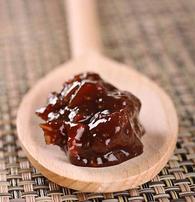
Serves: 2 jars
Cooking time: 10 minutes
Ingredients:
250 g pitted dates
60 g dried chillies
5 cloves garlic
60 g root ginger
250 ml brown vinegar
salt, to taste
Cooking instructions:
Place all the ingredients, except the vinegar, in a food processor and blend until smooth.
Add the vinegar and continue blending.
Place the mixture in a saucepan and bring to a boil.
Let the mixture cool down if serving straight away, otherwise spoon into sterilised jars while still hot.
Cook's note: this chutney goes excellently with lamb curry in a bunny chow made with individual potbrood.
BRON:Monche Muller.
Cooking time: 10 minutes
Ingredients:
250 g pitted dates
60 g dried chillies
5 cloves garlic
60 g root ginger
250 ml brown vinegar
salt, to taste
Cooking instructions:
Place all the ingredients, except the vinegar, in a food processor and blend until smooth.
Add the vinegar and continue blending.
Place the mixture in a saucepan and bring to a boil.
Let the mixture cool down if serving straight away, otherwise spoon into sterilised jars while still hot.
Cook's note: this chutney goes excellently with lamb curry in a bunny chow made with individual potbrood.
BRON:Monche Muller.
FRUIT CHUTNEY
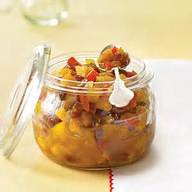
Like mrs Ball's]
200 grams dried pears, chopped
200 grams dried apricots, chopped
200 grams dates, chopped
200 grams dried apple rings, chopped
200 grams sultanas
1 liter water
500 milliliters cider vinegar
400 grams brown sugar
2 milligrams chili powder
2 milligrams turmeric
2 milligrams freshly grated nutmeg
2 milligrams freshly ground ginger
1 clove crushed garlic
Place the fruit and water in a large bowl. Cover the bowl and leave it overnight. Combine the undrained fruit mixture with the remaining ingredients in a large saucepan. Simmer over low heat, stirring, until the sugar has dissolved. Bring to the boil then simmer over low heat uncovered, for about 1 1/2 hours, or until thick, stirring occasionally. Pour into clean warm jars while hot. Fill to within 1.5 cm of the top and cover tightly with airtight, plastic screw-on or pop-on lids, not metal ones, which will corrode from the action of the spices and vinegar. Leave to mature in a cool, dry, dark place for 6-8 weeks before use.
200 grams dried pears, chopped
200 grams dried apricots, chopped
200 grams dates, chopped
200 grams dried apple rings, chopped
200 grams sultanas
1 liter water
500 milliliters cider vinegar
400 grams brown sugar
2 milligrams chili powder
2 milligrams turmeric
2 milligrams freshly grated nutmeg
2 milligrams freshly ground ginger
1 clove crushed garlic
Place the fruit and water in a large bowl. Cover the bowl and leave it overnight. Combine the undrained fruit mixture with the remaining ingredients in a large saucepan. Simmer over low heat, stirring, until the sugar has dissolved. Bring to the boil then simmer over low heat uncovered, for about 1 1/2 hours, or until thick, stirring occasionally. Pour into clean warm jars while hot. Fill to within 1.5 cm of the top and cover tightly with airtight, plastic screw-on or pop-on lids, not metal ones, which will corrode from the action of the spices and vinegar. Leave to mature in a cool, dry, dark place for 6-8 weeks before use.
SPICED SUMMER POACHED FRUIT
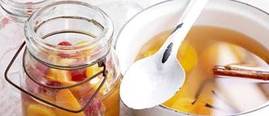
Serves 4.
750 ml bottle sparkling wine
1 vanilla bean
1 cinnamon stick
2 tbs honey
¼ cup white sugar
8 nectarines, halved OR use a combination of nectarines, peaches and apricots
1 punnet raspberries
In a large saucepan, bring the wine, sugar, honey and cinnamon stick to a boil.
Split vanilla bean lengthwise and scrape out the seeds.
Add the seeds and scraped vanilla bean to the saucepan.
Add nectarines and pour over enough water to cover.
Simmer gently for 15 minutes until tender.
Transfer fruit to a large bowl.
Simmer liquid until reduced to 1 cup, then remove from heat.
Discard vanilla bean.
Transfer fruit to a clean, warm jar carefully adding raspberries in between.
Pour liquid over the fruit to cover.
Seal jars, label and refrigerate.
750 ml bottle sparkling wine
1 vanilla bean
1 cinnamon stick
2 tbs honey
¼ cup white sugar
8 nectarines, halved OR use a combination of nectarines, peaches and apricots
1 punnet raspberries
In a large saucepan, bring the wine, sugar, honey and cinnamon stick to a boil.
Split vanilla bean lengthwise and scrape out the seeds.
Add the seeds and scraped vanilla bean to the saucepan.
Add nectarines and pour over enough water to cover.
Simmer gently for 15 minutes until tender.
Transfer fruit to a large bowl.
Simmer liquid until reduced to 1 cup, then remove from heat.
Discard vanilla bean.
Transfer fruit to a clean, warm jar carefully adding raspberries in between.
Pour liquid over the fruit to cover.
Seal jars, label and refrigerate.
GREEN FIG PRESERVE
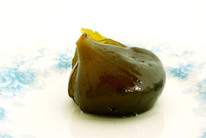
This is Faldela Williams’ recipe for green fig preserve.
Ingredients
•2 kg green figs (from the first crop before the end of October - otherwise
it is too ripe and become bitter when preserved)
•2.5 kg sugar
•2.5 litre water
•2 ml (1/2 teaspoon) lemon juice
•5 ml (1 teaspoon) ground dried ginger
For the lime solution:
•5 litres water
•25 ml (5 teaspoons) slaked lime (calcium hydroxide, which can be found at pharmacies)
•5 ml (1 teaspoon) bicarbonate of soda
Ingredients
1.Remove skins from the figs with a fine grater or a serrated knife and cut a cross in stem end of each.
2.Make the lime solution and soak figs in it overnight.
3.The next day, boil the figs in 3 litres of water for about 20 minutes until they are tender and drain.
4.Bring 2.5 litre water and the sugar, lemon juice and ginger to the boil. Add the figs one by one and boil rapidly until the figs are soft enough to break open but still crisp, and the syrup is thick. This will take 45 to 60 minutes.
5.Bottle in hot sterilised jars, and fill the bottles to the brim with the syrup.
Notes:
In her Afrikaans book about preserving food, Lekker vir Later, Annette Human describes a somewhat different recipe.
She soak her figs overnight in a mixture of 25 ml (5 teaspoons) salt per 2,5 litre water and rinse it well the next morning.
She then boils up 2 ml (1/2 teaspoon) blue vitriol or copper sulphate in water,
add the figs and remove immediately when the water starts boiling again and rinse off well with cold water.
This ensures that the figs have a lovely green colour – though we don’t recommend this specific step.
The figs are then boiled again in fresh water but with fig leaves, for about 4 minutes, until the figs are soft.
For the sauce, Annette Human use 7.5 litre water, 3 kg white sugar and 50 ml lemon juice or 10 ml cream of tartar per 2.5 kg figs.
The figs are boiled in the syrup for about half an hour and then left in it overnight.
The next morning, the syrup is boiled again, the figs are added again, and when it starts to boil again, bottled in sterilized jars
Bron: Rainbow Cooking
Plasing: Henriette Wessels
Ingredients
•2 kg green figs (from the first crop before the end of October - otherwise
it is too ripe and become bitter when preserved)
•2.5 kg sugar
•2.5 litre water
•2 ml (1/2 teaspoon) lemon juice
•5 ml (1 teaspoon) ground dried ginger
For the lime solution:
•5 litres water
•25 ml (5 teaspoons) slaked lime (calcium hydroxide, which can be found at pharmacies)
•5 ml (1 teaspoon) bicarbonate of soda
Ingredients
1.Remove skins from the figs with a fine grater or a serrated knife and cut a cross in stem end of each.
2.Make the lime solution and soak figs in it overnight.
3.The next day, boil the figs in 3 litres of water for about 20 minutes until they are tender and drain.
4.Bring 2.5 litre water and the sugar, lemon juice and ginger to the boil. Add the figs one by one and boil rapidly until the figs are soft enough to break open but still crisp, and the syrup is thick. This will take 45 to 60 minutes.
5.Bottle in hot sterilised jars, and fill the bottles to the brim with the syrup.
Notes:
In her Afrikaans book about preserving food, Lekker vir Later, Annette Human describes a somewhat different recipe.
She soak her figs overnight in a mixture of 25 ml (5 teaspoons) salt per 2,5 litre water and rinse it well the next morning.
She then boils up 2 ml (1/2 teaspoon) blue vitriol or copper sulphate in water,
add the figs and remove immediately when the water starts boiling again and rinse off well with cold water.
This ensures that the figs have a lovely green colour – though we don’t recommend this specific step.
The figs are then boiled again in fresh water but with fig leaves, for about 4 minutes, until the figs are soft.
For the sauce, Annette Human use 7.5 litre water, 3 kg white sugar and 50 ml lemon juice or 10 ml cream of tartar per 2.5 kg figs.
The figs are boiled in the syrup for about half an hour and then left in it overnight.
The next morning, the syrup is boiled again, the figs are added again, and when it starts to boil again, bottled in sterilized jars
Bron: Rainbow Cooking
Plasing: Henriette Wessels
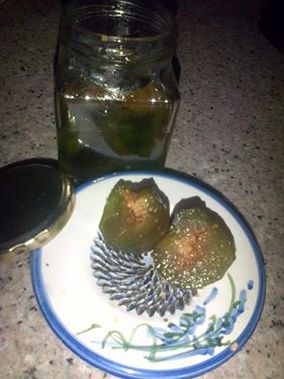
GREEN FIG PRESERVE
GREEN FIG PRESERVE
INGREDIENTS:
1 kg green figs
15 ml slaked lime
10 cups water
1.25 kg sugar
20 ml lemon juice
METHOD:
Scrape the figs with a knife and make a cross on the rounded bottom of each fig.
Make a lime solution by stirring the slaked lime into 10 cups of water, and soak the figs overnight.
This ensures that the preserve will be tender yet crisp.
Rinse thoroughly the next day in fresh water and leave to soak for 15 minutes.
Drain and then boil in a fresh batch of water enough to cover the fruit for about 15 minutes, or until tender.
Remove the figs, reserving the water and allow draining and cooling slightly in a colander.
Prepare the syrup by pouring 8 cups of the water that the figs where boiled into a saucepan with the sugar,
add the lemon juice and bring the syrup to the boil, while stirring to dissolve the sugar.
Squeeze the excess water from each fig, place them one at a time, in the boiling syrup, ensuring that the
syrup does not stop boiling. Boil uncoverd, until the figs are tender and translucent and the syrup is thick.
Spoon the figs and syrup into hot, dry sterilized jars and seal immediately.
Recipe By: South African Cookbook Reads Digest (Giggling Gourmet)
Plasing & Foto: Tina de Comarmond / WATERTAND RESEPTE VIR OUD EN JONK
GREEN FIG PRESERVE
INGREDIENTS:
1 kg green figs
15 ml slaked lime
10 cups water
1.25 kg sugar
20 ml lemon juice
METHOD:
Scrape the figs with a knife and make a cross on the rounded bottom of each fig.
Make a lime solution by stirring the slaked lime into 10 cups of water, and soak the figs overnight.
This ensures that the preserve will be tender yet crisp.
Rinse thoroughly the next day in fresh water and leave to soak for 15 minutes.
Drain and then boil in a fresh batch of water enough to cover the fruit for about 15 minutes, or until tender.
Remove the figs, reserving the water and allow draining and cooling slightly in a colander.
Prepare the syrup by pouring 8 cups of the water that the figs where boiled into a saucepan with the sugar,
add the lemon juice and bring the syrup to the boil, while stirring to dissolve the sugar.
Squeeze the excess water from each fig, place them one at a time, in the boiling syrup, ensuring that the
syrup does not stop boiling. Boil uncoverd, until the figs are tender and translucent and the syrup is thick.
Spoon the figs and syrup into hot, dry sterilized jars and seal immediately.
Recipe By: South African Cookbook Reads Digest (Giggling Gourmet)
Plasing & Foto: Tina de Comarmond / WATERTAND RESEPTE VIR OUD EN JONK
GRANADELLA CURD(PASSION FRUIT)
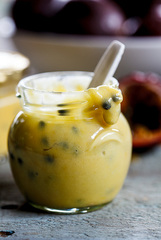
I love having it with Greek yoghurt for breakfast, I love eating it out of the jar
just as is and it is just divine when used for a granadilla meringue tart. Also Lovely to use in desserts
GRANADILLA (PASSION FRUIT) CURD
Prep time: 5 mins
Cook time: 15 mins
Total time: 20 mins
Ingredients
•1 cup passion fruit/granadilla pulp and seeds (approximately 10 passion fruit)
•2 eggs
•3 egg yolks
•150g caster sugar
•100g butter, cubed
Instructions
1.Combine all the ingredients in a heat-proof bowl and set it over a bowl of simmering water, making sure the bottom of the bowl doesn’t touch the water.
2.Stirring continuously, allow the butter to melt and the mixture to come together. At first the mixture is going to look strange and curdled but just continue stirring and when the butter is melted, switch to a whisk and whisk until the curd is thick and glossy.
3.Taste to ensure the curd is smooth and cooked through then remove from the heat.
4.Transfer the curd to clean jars and keep in the fridge for up to 2-3 weeks.
Bron: Simply Delicious
Plasing; Henriette Wessels
just as is and it is just divine when used for a granadilla meringue tart. Also Lovely to use in desserts
GRANADILLA (PASSION FRUIT) CURD
Prep time: 5 mins
Cook time: 15 mins
Total time: 20 mins
Ingredients
•1 cup passion fruit/granadilla pulp and seeds (approximately 10 passion fruit)
•2 eggs
•3 egg yolks
•150g caster sugar
•100g butter, cubed
Instructions
1.Combine all the ingredients in a heat-proof bowl and set it over a bowl of simmering water, making sure the bottom of the bowl doesn’t touch the water.
2.Stirring continuously, allow the butter to melt and the mixture to come together. At first the mixture is going to look strange and curdled but just continue stirring and when the butter is melted, switch to a whisk and whisk until the curd is thick and glossy.
3.Taste to ensure the curd is smooth and cooked through then remove from the heat.
4.Transfer the curd to clean jars and keep in the fridge for up to 2-3 weeks.
Bron: Simply Delicious
Plasing; Henriette Wessels
PRESERVING GUAVAS
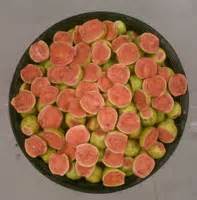
Peel firm and ripe guavas and cut them in half.
Remove all the bruised and damaged parts of the fruit.
Pack fruit in bottles to be used to measure them and then use syrup guidelines given below.
Prepare the syrup by dissolving 250 ml sugar in 500 ml water and bring to the boil.
You will need more or less 250 – 350 ml syrup per large glass bottle and 125 – 200 ml syrup for a smaller bottle.
Place the peeled guavas in the boiling syrup and cook for about 10 – 15 minutes or until froth starts to appear on top of the syrup or the pips start to loosen.
Be careful not to overcook guavas.
Overcooked guavas loose their pips.
Remove the labels from the glass bottles for the cooked guavas by soaking them in water.
Sterilise the bottles by boiling them in water for 30 minutes.
All the bottles used must have metal caps and should not be cracked or chipped.
Remove the bottles from the boiling water and pack with cooked guavas and then fill with syrup to the rim.
Remove all the air bubbles by inserting a knife against the inside of the bottles.
Close the cap tightly and place the bottle upside down while it cools.
This will ensure that the bottles seal properly.
The bottles must be sealed tightly.
Any bottles that leaks should rather be used immediately.
BRON:Martha de Lange
Remove all the bruised and damaged parts of the fruit.
Pack fruit in bottles to be used to measure them and then use syrup guidelines given below.
Prepare the syrup by dissolving 250 ml sugar in 500 ml water and bring to the boil.
You will need more or less 250 – 350 ml syrup per large glass bottle and 125 – 200 ml syrup for a smaller bottle.
Place the peeled guavas in the boiling syrup and cook for about 10 – 15 minutes or until froth starts to appear on top of the syrup or the pips start to loosen.
Be careful not to overcook guavas.
Overcooked guavas loose their pips.
Remove the labels from the glass bottles for the cooked guavas by soaking them in water.
Sterilise the bottles by boiling them in water for 30 minutes.
All the bottles used must have metal caps and should not be cracked or chipped.
Remove the bottles from the boiling water and pack with cooked guavas and then fill with syrup to the rim.
Remove all the air bubbles by inserting a knife against the inside of the bottles.
Close the cap tightly and place the bottle upside down while it cools.
This will ensure that the bottles seal properly.
The bottles must be sealed tightly.
Any bottles that leaks should rather be used immediately.
BRON:Martha de Lange
HONEY BUTTER
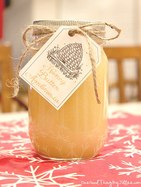
Ingredients
1 cup sugar
1 cup heavy cream
1 cup honey
3 sticks butter (or 3/4 lb), softened
1 tsp vanilla (this was a last minute addition…so it’s not in the picture) Or a vanilla bean would be a nice addition.
Instructions
In a sauce pan combine sugar, cream and honey. Heat on medium high heat and stir until it comes to a boil. Boil for 1 minute.
Put the softened butter in a blender or food processor, and pour the hot mixture over the butter. Blend on medium speed until mixed well. Add vanilla, and blend again. Pour mixture into a container, cover and let cool in the refrigerator. Keep refrigerated
1 cup sugar
1 cup heavy cream
1 cup honey
3 sticks butter (or 3/4 lb), softened
1 tsp vanilla (this was a last minute addition…so it’s not in the picture) Or a vanilla bean would be a nice addition.
Instructions
In a sauce pan combine sugar, cream and honey. Heat on medium high heat and stir until it comes to a boil. Boil for 1 minute.
Put the softened butter in a blender or food processor, and pour the hot mixture over the butter. Blend on medium speed until mixed well. Add vanilla, and blend again. Pour mixture into a container, cover and let cool in the refrigerator. Keep refrigerated
HONEY MUSTARD CANNING
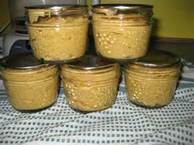
3/4 cup mustard powder
1/3 cup honey
1 cup cider vinegar
3 whole eggs, slightly beaten
In the top of a double boiler over simmering water combine all the ingredients, stirring until smooth and well combined.
Continue to cook for 10 minutes or until thick and smooth.
Pour into clean, hot sterile jars and seal.
Process in a boiling water bath for 10 minutes
1/3 cup honey
1 cup cider vinegar
3 whole eggs, slightly beaten
In the top of a double boiler over simmering water combine all the ingredients, stirring until smooth and well combined.
Continue to cook for 10 minutes or until thick and smooth.
Pour into clean, hot sterile jars and seal.
Process in a boiling water bath for 10 minutes
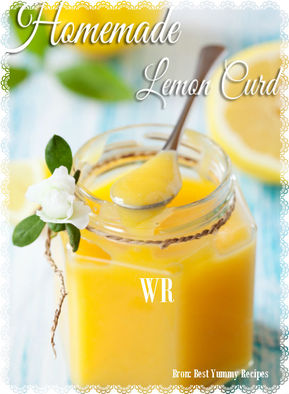
HOME MADE LEMON CURD
HOME MADE LEMON CURD
INGREDIENTS:
1/4 cup fresh lemon zest ( we used 3 large lemons to make the zest)
1/3 cup freshly squeezed lemon juice ( this will depend on the size of your lemons)
1/2 cup granulated sugar ( we used cane sugar)
1/8 teaspoon salt
4 egg yolks
6 Tablespoons butter (3/4 stick), cut into 6 pieces , at room temperature
(Makes about 1 1/2 cups)
DIRECTIONS:
Zest your lemons.
Squeeze the lemons.
Seperate the egg yolks from the whites. You only need the yolks for this recipe.
In a heat proof bowl, combine the lemon zest, juice, sugar and salt and stir together.
Select a pan to fit the heat proof bowl and put about two inches of water in it. Bring it to the boil, then turn it down to simmer.
Put the heat proof bowl with ingredients already in it into the pot with the heated water.
Whisk in the egg yolks.
Let this cook for about 7-10 minutes, whisking while it is cooking. Once the mixture thickens you can remove it from the hot water pot.
Whisk in the butter pieces, one at a time until all the butter is in the curd.
Your curd can now be transferred to a container.
If you do not like the texture of the zest in the curd, you can put the curd through a strainer to remove it.
We happen to like the texture so we leave it in.
Keep the lemon curd refrigerated. The curd is now ready for you to use with other recipes.
Bron: Best Yummy Recipes
Plasing: Henriette Wessels / WATERTAND RESEPTE VIR OUD EN JONK
HOME MADE LEMON CURD
INGREDIENTS:
1/4 cup fresh lemon zest ( we used 3 large lemons to make the zest)
1/3 cup freshly squeezed lemon juice ( this will depend on the size of your lemons)
1/2 cup granulated sugar ( we used cane sugar)
1/8 teaspoon salt
4 egg yolks
6 Tablespoons butter (3/4 stick), cut into 6 pieces , at room temperature
(Makes about 1 1/2 cups)
DIRECTIONS:
Zest your lemons.
Squeeze the lemons.
Seperate the egg yolks from the whites. You only need the yolks for this recipe.
In a heat proof bowl, combine the lemon zest, juice, sugar and salt and stir together.
Select a pan to fit the heat proof bowl and put about two inches of water in it. Bring it to the boil, then turn it down to simmer.
Put the heat proof bowl with ingredients already in it into the pot with the heated water.
Whisk in the egg yolks.
Let this cook for about 7-10 minutes, whisking while it is cooking. Once the mixture thickens you can remove it from the hot water pot.
Whisk in the butter pieces, one at a time until all the butter is in the curd.
Your curd can now be transferred to a container.
If you do not like the texture of the zest in the curd, you can put the curd through a strainer to remove it.
We happen to like the texture so we leave it in.
Keep the lemon curd refrigerated. The curd is now ready for you to use with other recipes.
Bron: Best Yummy Recipes
Plasing: Henriette Wessels / WATERTAND RESEPTE VIR OUD EN JONK
HOME MADE HAZELNUT NUTELLA
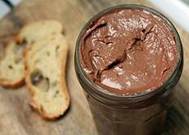
1/3 cup (40g) whole almonds
1 1/3 cup (160g) hazelnuts
1 3/4 cup (400g) full cream milk (see Notes)
7/8 cup (60g) powdered full cream milk
3 tablespoons (40g) mild-flavored honey or just honey
pinch of salt
170g bittersweet or semisweet chocolate, chopped
140g milk chocolate, chopped (use one that’s at least 30% cacao solids)
1. Spread the nuts on a baking sheet, keeping the almond separate, and toast the nuts in a 350ºF (180ºC) oven, stirring a few times, for 10 to 15 minutes, until the hazelnuts are browned.
2. While they are roasting, warm the whole milk and powdered milk in a small saucepan with the honey and salt just until it starts to boil. Remove from heat.
3. In a clean, dry bowl set over a pan of barely simmering water, or in a microwave oven, melt the chocolates together until smooth.
4. Once the nuts are well-toasted, remove them from oven and use a spatula to place the warm hazelnuts in a clean tea towel, then fold them inside the towel and rub them vigorously to remove any loose skins. They don’t need to be pristine; just try to get as much off as possible.
5. In a food processor, grind the warm hazelnuts and almonds until they’re as fine as possible. You may not be able to get them completely smooth, depending on your food processor. (I have a brand new one and even after five minutes, there were little bits of nuts in mine, which is normal.)
6. Add the melted chocolate and continue to process the mixture, stopping to scrape down the sides of the work bowl, as necessary.
7. Once the mixture is smooth, add the warm milk mixture and process until everything is well-combined.
(The original instructions here said to strain the paste, which I didn’t do because I don’t mind the little bits of toasted nuts, but you can.)
9. Transfer the mixture into two jars and refrigerate until ready to use.
Storage: The Chocolate-Hazelnut Paste will keep in the refrigerator for up to one week.
1 1/3 cup (160g) hazelnuts
1 3/4 cup (400g) full cream milk (see Notes)
7/8 cup (60g) powdered full cream milk
3 tablespoons (40g) mild-flavored honey or just honey
pinch of salt
170g bittersweet or semisweet chocolate, chopped
140g milk chocolate, chopped (use one that’s at least 30% cacao solids)
1. Spread the nuts on a baking sheet, keeping the almond separate, and toast the nuts in a 350ºF (180ºC) oven, stirring a few times, for 10 to 15 minutes, until the hazelnuts are browned.
2. While they are roasting, warm the whole milk and powdered milk in a small saucepan with the honey and salt just until it starts to boil. Remove from heat.
3. In a clean, dry bowl set over a pan of barely simmering water, or in a microwave oven, melt the chocolates together until smooth.
4. Once the nuts are well-toasted, remove them from oven and use a spatula to place the warm hazelnuts in a clean tea towel, then fold them inside the towel and rub them vigorously to remove any loose skins. They don’t need to be pristine; just try to get as much off as possible.
5. In a food processor, grind the warm hazelnuts and almonds until they’re as fine as possible. You may not be able to get them completely smooth, depending on your food processor. (I have a brand new one and even after five minutes, there were little bits of nuts in mine, which is normal.)
6. Add the melted chocolate and continue to process the mixture, stopping to scrape down the sides of the work bowl, as necessary.
7. Once the mixture is smooth, add the warm milk mixture and process until everything is well-combined.
(The original instructions here said to strain the paste, which I didn’t do because I don’t mind the little bits of toasted nuts, but you can.)
9. Transfer the mixture into two jars and refrigerate until ready to use.
Storage: The Chocolate-Hazelnut Paste will keep in the refrigerator for up to one week.
CANNEIED KUMQUARTS
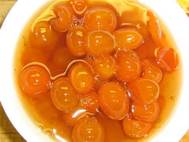
4 cups of roughly chopped kumquats (roughly 1-1½ lbs.)
1 cup of water
2 cups of sugar
1 With a pairing knife roughly chop the kumquats. Discard any seeds you can that are easy to get too, but they're edible so don't fret if some get chopped up or stay in the fruit. Feel free to leave any small kumquats whole.
2 Heat the water and sugar over high heat until it comes to a boil. Simmer for 4 minutes. Add the kumquats and simmer for 10 minutes.
3 Drain the kumquats through a sieve set over a bowl. Return the syrup to the pan and simmer for 5 minutes to reduce the syrup. Combine the kumquats and 1/4 cup of the syrup together.
Serve or jar and refrigerate. Can be stored for up to two weeks
1 cup of water
2 cups of sugar
1 With a pairing knife roughly chop the kumquats. Discard any seeds you can that are easy to get too, but they're edible so don't fret if some get chopped up or stay in the fruit. Feel free to leave any small kumquats whole.
2 Heat the water and sugar over high heat until it comes to a boil. Simmer for 4 minutes. Add the kumquats and simmer for 10 minutes.
3 Drain the kumquats through a sieve set over a bowl. Return the syrup to the pan and simmer for 5 minutes to reduce the syrup. Combine the kumquats and 1/4 cup of the syrup together.
Serve or jar and refrigerate. Can be stored for up to two weeks
KUMQUATS
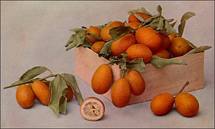
CANDIED KUMQUATS -
4 cups of roughly chopped kumquats (roughly 450 - 680 g)
1 cup of water
2 cups of sugar
With a pairing knife roughly chop the kumquats.
Discard any seeds you can that are easy to get too, but they're edible so don't fret if some get chopped up or stay in the fruit.
Feel free to leave any small kumquats whole.
Heat the water and sugar over high heat until it comes to a boil.
Simmer for 4 minutes.
Add the kumquats and simmer for 10 minutes.
Drain the kumquats through a sieve set over a bowl.
Return the syrup to the pan and simmer for 5 minutes to reduce the syrup.
Combine the kumquats and ¼ cup of the syrup together.
Serve or jar and refrigerate.
Can be stored for up to two weeks.
KUMQUAT PRESERVE 1 -
Select 5 kg of ripe kumquat and prick them with a fork.
Place the kumquats in a solution of 4 tbsp of salt to 6 litres of water.
Soak overnight.
The next day remove the kumquats and discard the salt water.
Place them in a large pot and cover with fresh cold water.
Bring to the boil.
Boil them for no longer than 10 minutes or they will become tough.
Make a syrup using 3 kg sugar to 6 litres of water.
Boil the kumquats rapidly in the syrup until the fruit is transparent and the syrup gels.
KUMQUAT PRESERVE 2
500 g kumquat
500 ml sugar
750 ml brandy
Wash kumquats and pierce each fruit a few times with a sterilized needle, or make a slit crossways at the top of each fruit.
Layer the fruit and sugar in a sterilized preserving jar.
Pour in the brandy until the fruit is completely covered.
Seal and store in a cool dark place.
Invert the jar occasionally.
The fruit will be ready to eat after four months.
4 cups of roughly chopped kumquats (roughly 450 - 680 g)
1 cup of water
2 cups of sugar
With a pairing knife roughly chop the kumquats.
Discard any seeds you can that are easy to get too, but they're edible so don't fret if some get chopped up or stay in the fruit.
Feel free to leave any small kumquats whole.
Heat the water and sugar over high heat until it comes to a boil.
Simmer for 4 minutes.
Add the kumquats and simmer for 10 minutes.
Drain the kumquats through a sieve set over a bowl.
Return the syrup to the pan and simmer for 5 minutes to reduce the syrup.
Combine the kumquats and ¼ cup of the syrup together.
Serve or jar and refrigerate.
Can be stored for up to two weeks.
KUMQUAT PRESERVE 1 -
Select 5 kg of ripe kumquat and prick them with a fork.
Place the kumquats in a solution of 4 tbsp of salt to 6 litres of water.
Soak overnight.
The next day remove the kumquats and discard the salt water.
Place them in a large pot and cover with fresh cold water.
Bring to the boil.
Boil them for no longer than 10 minutes or they will become tough.
Make a syrup using 3 kg sugar to 6 litres of water.
Boil the kumquats rapidly in the syrup until the fruit is transparent and the syrup gels.
KUMQUAT PRESERVE 2
500 g kumquat
500 ml sugar
750 ml brandy
Wash kumquats and pierce each fruit a few times with a sterilized needle, or make a slit crossways at the top of each fruit.
Layer the fruit and sugar in a sterilized preserving jar.
Pour in the brandy until the fruit is completely covered.
Seal and store in a cool dark place.
Invert the jar occasionally.
The fruit will be ready to eat after four months.
LEMON BUTTER (CURD)
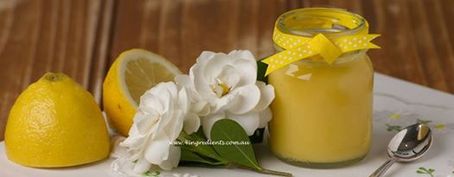
Our versatile lemon butter (curd) recipe from 4 Ingredients One Pot One Bowl.
Perfect for our little lemon cheesecakes, cupcakes, on top of scones, jam drops & much, much more!
LEMON BUTTER RECIPE:
Half a cup of butter
3 large lemons
Half a cups of sugar
3 free range eggs
Melt Butter. In a separate bowl, beat eggs until frothy, then juice the 3 lemons.
Add the juice, eggs and sugar to the butter and cook on a gentle heat until thick.
Pour into a jar and store in the fridge.
OPTIONAL:
Grate in the zest of a lemon.
For passionfruit butter, omit the lemon zest and use 1/2 cup passion fruit pulp and half a cup of lemon juice.
For more tips, options & hints check out this recipe on page 18 of 4 Ingredients One Pot One Bowl.
Tip:
Aussie Lemons are now in season. As the proud Ambassador for Citrus Australia, buy homegrown and support local farmers.
This is true no matter where you live in the world,think global, act local.
Bron: Onbekend
Plasing: Petra Pretorius / WATERTAND RESEPTE VIR OUD EN JONK
Perfect for our little lemon cheesecakes, cupcakes, on top of scones, jam drops & much, much more!
LEMON BUTTER RECIPE:
Half a cup of butter
3 large lemons
Half a cups of sugar
3 free range eggs
Melt Butter. In a separate bowl, beat eggs until frothy, then juice the 3 lemons.
Add the juice, eggs and sugar to the butter and cook on a gentle heat until thick.
Pour into a jar and store in the fridge.
OPTIONAL:
Grate in the zest of a lemon.
For passionfruit butter, omit the lemon zest and use 1/2 cup passion fruit pulp and half a cup of lemon juice.
For more tips, options & hints check out this recipe on page 18 of 4 Ingredients One Pot One Bowl.
Tip:
Aussie Lemons are now in season. As the proud Ambassador for Citrus Australia, buy homegrown and support local farmers.
This is true no matter where you live in the world,think global, act local.
Bron: Onbekend
Plasing: Petra Pretorius / WATERTAND RESEPTE VIR OUD EN JONK
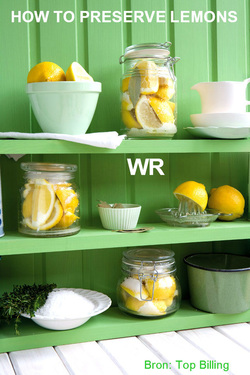
PRESERVED LEMONS
PRESERVED LEMONS
makes 1L jar
½ cup salt
5 lemons, scrubbed well
1 bay leaf
1 cinnamon stick
fresh lemon juice, to fill
METHOD:
Place 2T salt in the bottom of a 1-litre sterilised jar. Score four lemons in quarters, keeping the base attached. Pry the lemons open and generously sprinkle with the rest of the salt.
Pack the lemons in the jar, squashing them down to release as much juice as possible. Add the bay leaf and cinnamon stick and fill up the jar with enough lemon juice to cover the lemons.
Seal the jar and allow to stand at room temperature for a couple of days, turning the jar upside down occasionally. Place in the refrigerator, again turning occasionally, for at least three weeks before using.
Tips & ideas
Preserve the zest and juice of lemons by grating the rind and freezing in ice-block trays. Once frozen, store in a ziplock bag in the freezer. To use, simply pop it in the pot.
Preserve limes or oranges by using the same method.
To use, remove the lemon from the jar. Rinse under cold running water to remove salt. Pat dry. Remove the rind and chop as desired. Discard flesh and white pith – they’re too salty to use.
Shortcut
Use this shortcut if a recipe calls for preserved lemons and your shelf is bare!
Cut lemons in half, and then quarter without cutting through the skin. Simmer, covered with water to which 100g salt was added, for one hour. Place in sterilised jars, seal and allow to cool upside down. They will keep for five days in a sealed jar in the fridge.
Bron: Top Billing
Plasing: Henriette Wessels / WATERTAND RESEPTE VIR OUD EN JONK
PRESERVED LEMONS
makes 1L jar
½ cup salt
5 lemons, scrubbed well
1 bay leaf
1 cinnamon stick
fresh lemon juice, to fill
METHOD:
Place 2T salt in the bottom of a 1-litre sterilised jar. Score four lemons in quarters, keeping the base attached. Pry the lemons open and generously sprinkle with the rest of the salt.
Pack the lemons in the jar, squashing them down to release as much juice as possible. Add the bay leaf and cinnamon stick and fill up the jar with enough lemon juice to cover the lemons.
Seal the jar and allow to stand at room temperature for a couple of days, turning the jar upside down occasionally. Place in the refrigerator, again turning occasionally, for at least three weeks before using.
Tips & ideas
Preserve the zest and juice of lemons by grating the rind and freezing in ice-block trays. Once frozen, store in a ziplock bag in the freezer. To use, simply pop it in the pot.
Preserve limes or oranges by using the same method.
To use, remove the lemon from the jar. Rinse under cold running water to remove salt. Pat dry. Remove the rind and chop as desired. Discard flesh and white pith – they’re too salty to use.
Shortcut
Use this shortcut if a recipe calls for preserved lemons and your shelf is bare!
Cut lemons in half, and then quarter without cutting through the skin. Simmer, covered with water to which 100g salt was added, for one hour. Place in sterilised jars, seal and allow to cool upside down. They will keep for five days in a sealed jar in the fridge.
Bron: Top Billing
Plasing: Henriette Wessels / WATERTAND RESEPTE VIR OUD EN JONK
PRESERVED LIMES
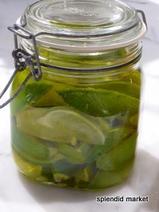
Ingredients
5 limes
3 cups coarse salt
up to 2 cups olive oil
1- 3/4 litre preserving jar, sterilized
Preparation
Wash and dry the limes well. Cut the limes lengthwise, in eighths.
Place lime slices in a Pyrex container. Pour salt over limes and toss them in the salt, ensuring that the pulp portion is completely coated with salt.
Cover the container and put them in the freezer for at least a day (a couple of days is fine too).
Remove from the freezer and thaw thoroughly. Put the limes into a colander and rinse off the salt with cold water.
Pack the limes into the sterilized preserving jar and cover them with olive oil.
It is important that the limes are completely covered with the oil, if they are not they will mold.
Close and put away in a dark place for at least 3 weeks before eating.
The longer you leave them, the more tender and exquisite they are..
5 limes
3 cups coarse salt
up to 2 cups olive oil
1- 3/4 litre preserving jar, sterilized
Preparation
Wash and dry the limes well. Cut the limes lengthwise, in eighths.
Place lime slices in a Pyrex container. Pour salt over limes and toss them in the salt, ensuring that the pulp portion is completely coated with salt.
Cover the container and put them in the freezer for at least a day (a couple of days is fine too).
Remove from the freezer and thaw thoroughly. Put the limes into a colander and rinse off the salt with cold water.
Pack the limes into the sterilized preserving jar and cover them with olive oil.
It is important that the limes are completely covered with the oil, if they are not they will mold.
Close and put away in a dark place for at least 3 weeks before eating.
The longer you leave them, the more tender and exquisite they are..
PRESEVED LEMONS
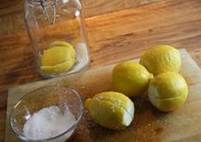
100 MILES*
10 ripe Meyer, or organic lemons
1/2 cup coarse salt
Extra virgin olive oil
Method
Scrub 6 of the lemons and dry well. Quarter the 6 lemons cutting from the top to 1/2 inch from the bottom leaving them intact at the base. Open the lemons gently and sprinkle salt on the exposed inner flesh, then reshape the fruit. Toss with the remaining salt and pack into a 3-4 cup dry, sterile Mason jar with a glass or plastic-coated lid.
With a wooden spoon, gently push down the lemons. Squeeze the juice from the remaining 4 lemons and pour into the jar. Close the jar tightly and let the lemons ripen at room temperature for 30 days, shaking the jar each day to redistribute the salt and juice. (Within a few days the salt will draw out enough juice to completely cover the lemons.)
For longer storage, add olive oil and refrigerate for up to 1 year. Rinse the lemons before using.
Note: you may add spices like cloves, coriander seeds, peppercorns, cinnamon stick, bay leaf or chiles to the lemons for an added layer of flavor. I would do so sparingly the first time. You may adjust the quantity in the next go around
10 ripe Meyer, or organic lemons
1/2 cup coarse salt
Extra virgin olive oil
Method
Scrub 6 of the lemons and dry well. Quarter the 6 lemons cutting from the top to 1/2 inch from the bottom leaving them intact at the base. Open the lemons gently and sprinkle salt on the exposed inner flesh, then reshape the fruit. Toss with the remaining salt and pack into a 3-4 cup dry, sterile Mason jar with a glass or plastic-coated lid.
With a wooden spoon, gently push down the lemons. Squeeze the juice from the remaining 4 lemons and pour into the jar. Close the jar tightly and let the lemons ripen at room temperature for 30 days, shaking the jar each day to redistribute the salt and juice. (Within a few days the salt will draw out enough juice to completely cover the lemons.)
For longer storage, add olive oil and refrigerate for up to 1 year. Rinse the lemons before using.
Note: you may add spices like cloves, coriander seeds, peppercorns, cinnamon stick, bay leaf or chiles to the lemons for an added layer of flavor. I would do so sparingly the first time. You may adjust the quantity in the next go around
AMLA MURABBA
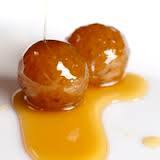
This is an invaluable winter preserve. Amlas (Indian gooseberries) are abundantly available during the winter months. You will find amla trees in several parts of Rajasthan and a large quantity of this fruit is used to make preserves. Whole amlas simmered in a cardamom and saffron flavoured syrup is one of my personal favourites. There are several traditional recipes for making this murabba. Some soak the amlas in alum (phitkari) overnight whilst others sun-dry amlas. I find it easiest to cook the amlas in boiling water to get rid of all the bitter juices. The entire process takes about 2 to 3 days. First, the amlas are simmered in a thin sugar syrup and left aside for 2 days during which the amlas slowly and gradually soak in the syrup. On the third day, amlas are removed and the syrup is boiled again to a thick honey like consistency. Thereafter the amlas and the flavouring are added. The thick syrup helps in the preservation of the murabba and also complements the sharp and acidic amla taste. I am sure you will enjoy this recipe as much I have enjoyed making it for you.
Ingredients
20 (500 grams) amlas (indian gooseberries)
2 1/2 cups (500 grams) sugar
1/4 tsp cardamom (elaichi) powder
a few saffron (kesar) strands
Method
Wash the amlas thoroughly. Prick them with a fork at regular intervals.
Boil plenty of water in a pan, add the amlas and boil for 10 minutes over a high flame. Drain and keep aside.
Dissolve the sugar in 3 cups of water and bring the syrup to a boil. Add the amlas and cook over a slow flame for about 30 to 40 minutes or until the amlas are soft.
Allow the mixture to cool completely. Keep covered in a cool dry place for at least 48 hours so that the amlas soak in the syrup.
Drain the amlas from the syrup, boil the syrup with cardamom powder and saffron till it reduces to a 2 to 3 string consistency. Add the amlas and simmer for 3 to 4 minutes.
Allow to cool completely.
Bottle in a sterilised glass jar. Store for upto 6 months dry in a cool place.
Ingredients
20 (500 grams) amlas (indian gooseberries)
2 1/2 cups (500 grams) sugar
1/4 tsp cardamom (elaichi) powder
a few saffron (kesar) strands
Method
Wash the amlas thoroughly. Prick them with a fork at regular intervals.
Boil plenty of water in a pan, add the amlas and boil for 10 minutes over a high flame. Drain and keep aside.
Dissolve the sugar in 3 cups of water and bring the syrup to a boil. Add the amlas and cook over a slow flame for about 30 to 40 minutes or until the amlas are soft.
Allow the mixture to cool completely. Keep covered in a cool dry place for at least 48 hours so that the amlas soak in the syrup.
Drain the amlas from the syrup, boil the syrup with cardamom powder and saffron till it reduces to a 2 to 3 string consistency. Add the amlas and simmer for 3 to 4 minutes.
Allow to cool completely.
Bottle in a sterilised glass jar. Store for upto 6 months dry in a cool place.
PAPAYA MANGO SALSA
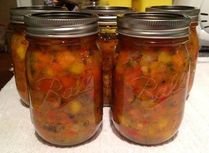
• 1 large orange papaya, large dice
• 2 small yellow papayas, small dice
• 3-4 tbsp. papaya seeds
• 2 medium yellow mangos, medium dice
• 1 medium red onion, medium dice
• 1 medium red bell pepper, fine diced
• 3 large Serrano chilis, cleaned/fine dice
• 2-3 tbsp. fresh ginger, minced
• 1 bushel cilantro, fine chop
• ½ cup lemon juice
• ½ cup lime juice
• ¼ cup distilled white vinegar
• 1 tsp. Kosher salt
Processing:
• In a large nonreactive pot add everything except papaya seeds and cilantro.
• Bring to a boil, lower to simmer, cook 10-15 minutes.
• Turn off heat and add papaya seeds and cilantro.
• Let stand 5 minutes and stir.
Bottling/Canning:
• Fill jars leaving ½" room on top, cook for 15 minutes.
Yield:• Makes about 5 pints (filled 4 jars, with 1 about ¾ full for the fridge).
• 2 small yellow papayas, small dice
• 3-4 tbsp. papaya seeds
• 2 medium yellow mangos, medium dice
• 1 medium red onion, medium dice
• 1 medium red bell pepper, fine diced
• 3 large Serrano chilis, cleaned/fine dice
• 2-3 tbsp. fresh ginger, minced
• 1 bushel cilantro, fine chop
• ½ cup lemon juice
• ½ cup lime juice
• ¼ cup distilled white vinegar
• 1 tsp. Kosher salt
Processing:
• In a large nonreactive pot add everything except papaya seeds and cilantro.
• Bring to a boil, lower to simmer, cook 10-15 minutes.
• Turn off heat and add papaya seeds and cilantro.
• Let stand 5 minutes and stir.
Bottling/Canning:
• Fill jars leaving ½" room on top, cook for 15 minutes.
Yield:• Makes about 5 pints (filled 4 jars, with 1 about ¾ full for the fridge).
GINGER PEAR CHUTNEY
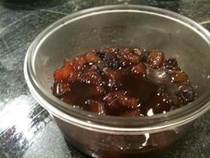
Great way to use up pears, including recent windfalls as they've got to be peeled and chopped anyway. Nice with pork or as a condiment ...
10 cups peeled chopped pears
4 cups granulated sugar
1 cup seedless raisin
1 cup finely chopped crystallized ginger
3 cups cider vinegar
1 teaspoon salt
1 teaspoon cinnamon
1/2 teaspoon ground allspice
1/2 teaspoon ground cloves
Directions:
In large preserving kettle or dutch oven, combine all ingredients and bring to a boil, stirring frequently.
Reduce heat and simmer, uncovered, for about 1 1/2 hours, continuing to stir occasionally.
Remove from heat and pour into hot, sterilized jars, leaving 1/8 inch headspace. Add lids and rings and process jars in a boiling water bath in a canner for 15 minutes. Take the canner off the heat and let water stop boiling before removing jars. Carefully remove jars and let sit. As they cool, the jars will seal themselves with a"pop". Label, and store in cool, dry, dark place.
To prepare the jars, I first wash them in the dishwasher, or in the sink with very hot, soapy water, then rinse them well and put them in a warm oven, taking the jars out one or two at a time when filling them.
I soak the lids in very hot water and put them immediately from the hot water onto the filled jars, making sure the rims of the jars are clean, then add the rings (which I've also soaked in hot water) and screw them on the jars just finger tight.
BRON:Kathleen Constance's Note:
10 cups peeled chopped pears
4 cups granulated sugar
1 cup seedless raisin
1 cup finely chopped crystallized ginger
3 cups cider vinegar
1 teaspoon salt
1 teaspoon cinnamon
1/2 teaspoon ground allspice
1/2 teaspoon ground cloves
Directions:
In large preserving kettle or dutch oven, combine all ingredients and bring to a boil, stirring frequently.
Reduce heat and simmer, uncovered, for about 1 1/2 hours, continuing to stir occasionally.
Remove from heat and pour into hot, sterilized jars, leaving 1/8 inch headspace. Add lids and rings and process jars in a boiling water bath in a canner for 15 minutes. Take the canner off the heat and let water stop boiling before removing jars. Carefully remove jars and let sit. As they cool, the jars will seal themselves with a"pop". Label, and store in cool, dry, dark place.
To prepare the jars, I first wash them in the dishwasher, or in the sink with very hot, soapy water, then rinse them well and put them in a warm oven, taking the jars out one or two at a time when filling them.
I soak the lids in very hot water and put them immediately from the hot water onto the filled jars, making sure the rims of the jars are clean, then add the rings (which I've also soaked in hot water) and screw them on the jars just finger tight.
BRON:Kathleen Constance's Note:
CHAMPANGNE SOAKED STRAWBERRIES
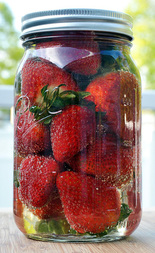
1 pacakge of fresh strawberries
1 bottle of champagne
1 canning jar
1 bag of white melting chocolate
Bottle of blue sugar
sprinkles
Directions:
Fill your canning jar with
strawberries and fill with champagne.
Allow to set for at least 24 hours.
If you are in a pinch for time, you can poke small holes in the strawberries
with a tooth pick to allow the champagne to penetrate faster.
Pat dry the strawberries
Melt your white chocolate in a small pan.
Dip your strawberries into the chocolate.
Place down and let the chocolate set a bit (30-45 seconds).
If you dip it immediately into the sprinkles your chocolate will bunch up.
Enjoy!
These do not hold very well. About 2-3 days in the fridge tops, so only make as much as you need
Bron: Onbekend
Plasing: Henriette Wessels
1 bottle of champagne
1 canning jar
1 bag of white melting chocolate
Bottle of blue sugar
sprinkles
Directions:
Fill your canning jar with
strawberries and fill with champagne.
Allow to set for at least 24 hours.
If you are in a pinch for time, you can poke small holes in the strawberries
with a tooth pick to allow the champagne to penetrate faster.
Pat dry the strawberries
Melt your white chocolate in a small pan.
Dip your strawberries into the chocolate.
Place down and let the chocolate set a bit (30-45 seconds).
If you dip it immediately into the sprinkles your chocolate will bunch up.
Enjoy!
These do not hold very well. About 2-3 days in the fridge tops, so only make as much as you need
Bron: Onbekend
Plasing: Henriette Wessels
WATERMELON RIND PICKLES
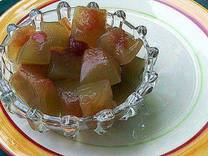
Ingredients:
1 quart or so watermelon rind chunks
1 quart water
1/4 cup pickling salt or Kosher salt
1 cup vinegar
1-1/2 cups sugar
1/2 sliced lemon
2 cinnamon sticks
8 cloves
6 allspice berries
Directions:
Day 1: Prepare the rind by removing the green part, and cutting the rind into uniform sized chunks. Some instructions say to completely remove all pink flesh, but a little bit adds interest to the pickle. The easiest way for me to cut the rind into pieces is to cut strips, then cut the chunks, then remove a thin layer, just enough to remove the very outside of the green peel, from each chunk separately.
Place the rind in a pickling crock, a plastic bowl, or a non-reactive pan. Cover it with a brine made from the one quart water, and 1/4 cup pickling salt. Place a plate on top and weigh it down to keep the rind submerged. Allow it to sit in a cool place over night or at least 8 hours.
Day 2: Drain and rinse the rind. Place the rind in a cooking pot and cover with fresh water. Boil until it is soft, and drain again. Meanwhile make a syrup of 1 cup vinegar, 1 1/2 cups sugar, and 1/2 sliced lemon. Heat and stir until the sugar is dissolved. Add the rind to the syrup and cook until the rind is translucent.
For each pint, place 1 cinnamon stick (about 2 inches long), four cloves, and 3 allspice berries into a pint jar, double the amount into a quart jar. Use a slotted spoon to add the rind. Cover with syrup leaving 1/2 inch head space. Wipe rims, cap and place in a hot water bath. Process pints for 10 minutes, quart jars for 15 minutes.
1 quart or so watermelon rind chunks
1 quart water
1/4 cup pickling salt or Kosher salt
1 cup vinegar
1-1/2 cups sugar
1/2 sliced lemon
2 cinnamon sticks
8 cloves
6 allspice berries
Directions:
Day 1: Prepare the rind by removing the green part, and cutting the rind into uniform sized chunks. Some instructions say to completely remove all pink flesh, but a little bit adds interest to the pickle. The easiest way for me to cut the rind into pieces is to cut strips, then cut the chunks, then remove a thin layer, just enough to remove the very outside of the green peel, from each chunk separately.
Place the rind in a pickling crock, a plastic bowl, or a non-reactive pan. Cover it with a brine made from the one quart water, and 1/4 cup pickling salt. Place a plate on top and weigh it down to keep the rind submerged. Allow it to sit in a cool place over night or at least 8 hours.
Day 2: Drain and rinse the rind. Place the rind in a cooking pot and cover with fresh water. Boil until it is soft, and drain again. Meanwhile make a syrup of 1 cup vinegar, 1 1/2 cups sugar, and 1/2 sliced lemon. Heat and stir until the sugar is dissolved. Add the rind to the syrup and cook until the rind is translucent.
For each pint, place 1 cinnamon stick (about 2 inches long), four cloves, and 3 allspice berries into a pint jar, double the amount into a quart jar. Use a slotted spoon to add the rind. Cover with syrup leaving 1/2 inch head space. Wipe rims, cap and place in a hot water bath. Process pints for 10 minutes, quart jars for 15 minutes.